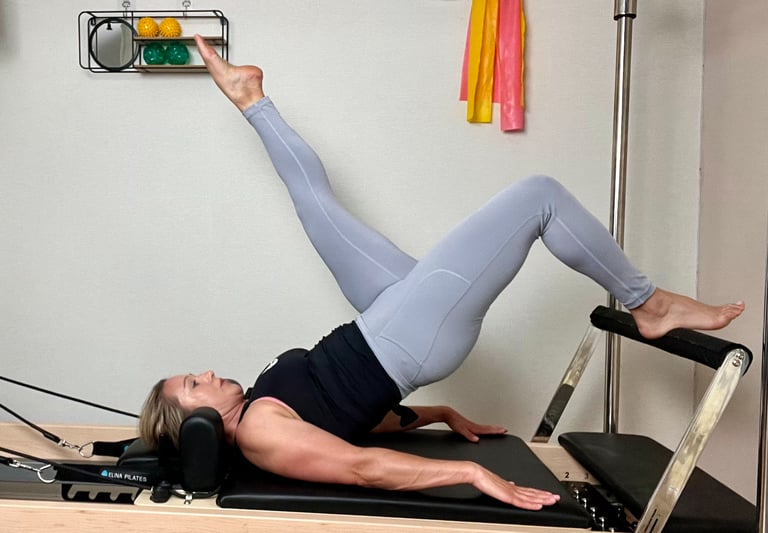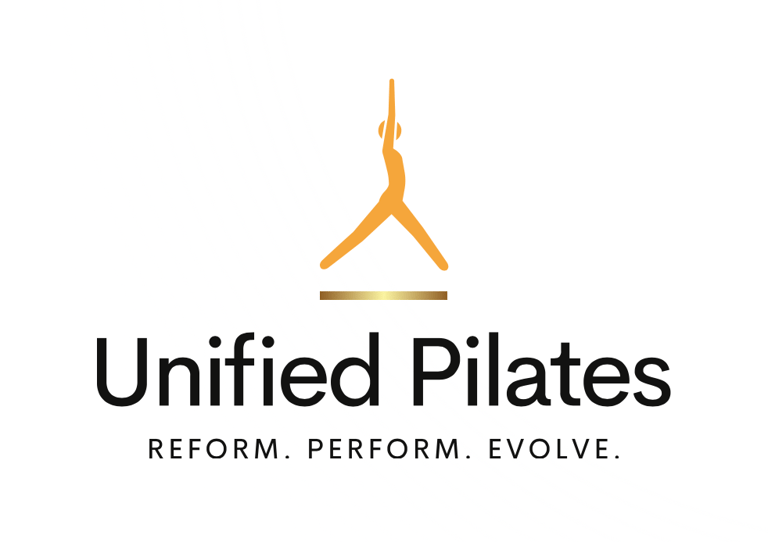
Got a Reformer at Home? Don’t Skip This Step If You Want Real Results
Got a Reformer at home? Here’s how to build the strength, control, and confidence to get the most out of it — starting on the mat. In this post, I break down why mat-based prep is key to mastering your Reformer sessions, the essential movement patterns to focus on, and how smart foundations lead to better results.
5/25/20256 min read
Pilates is more than just a collection of exercises — it’s a progressive system, with each piece of apparatus designed to either support movement or challenge it further. The Reformer is one part of that system, and while it’s a powerful tool, the foundation often begins on the mat.
Starting Reformer Pilates for the first time can feel exciting… and slightly intimidating. The machine looks like a medieval bed of springs, and suddenly you’re asked to balance, press, glide — and breathe all at once. Before jumping into a full Reformer class, a little mat prep can go a long way — helping you feel more connected, confident, and in control. Think of them as the “pre-reformer prep” — building body awareness and core control so that when you step up to the machine, you move safely and with confidence.
In studio classes, we often blend mat fundamentals with Reformer work to build a strong, safe foundation. That’s why it’s so important for anyone practicing at home with a Reformer to start with these basics—and get expert guidance to ensure you’re moving effectively and safely. Taking the time to master these foundational movements will help you get the most from your Reformer workouts. When you master these foundational movements you'll feel more confident, safe, and strong in your first Reformer class.
Some of the exercises in this blog are not strictly classical Pilates (like Bird Dog or Watchdog), but they are intentionally included to support the key principles of stability and control. Think of them as stepping stones — building blocks to get more out of your Reformer training. If you find certain mat movements — like a full Roll Up — particularly challenging, don’t worry. In a studio setting, a teacher might use the Cadillac or Tower to assist that motion and help you build strength progressively. But if you're working from home, the mat remains your most accessible and valuable place to begin.
And a note on safety. If you have any movement restrictions, past injuries, or medical conditions (such as osteoporosis or disc issues), not every exercise will be right for you. Always check in with a healthcare provider or movement professional to understand which movements to avoid or modify. It’s about training smart — so your practice can support your health, not challenge it.
Mat Prep: Your Foundation for Reformer Success
Mat work isn’t just a warm-up or beginner option — it’s where you build the control, alignment, and deep core connection that the Reformer will later challenge. It teaches you how to:
Stabilize your spine
Activate your pelvic floor
Coordinate breath with movement
Move with awareness instead of momentum
In a well-structured studio class, we layer these mat fundamentals into Reformer sessions. But at home, without guidance, it’s easy to skip the basics — and that's often where people hit a wall (or worse, experience discomfort or re-aggravate an old injury). That’s why starting with a tailored plan is more than just helpful — it’s smart, safe, and efficient.
Build the Skills That Set You Up for Success
Let’s take a look at a few examples of how mat prep connects directly to stronger Reformer sessions. Learning these first on the mat sets you up for smoother, more successful movement when you get on the Reformer. Let’s take a look at how specific mat exercises lay the groundwork for stronger, safer Reformer sessions:
Roll Downs on the Mat ➡️ Reformer Roll Downs / Short Box Abdominals
You’ll strengthen your core, improve spinal mobility, and learn to control your descent — so when you add the moving carriage, you’re already aligned and aware.Hundred on the Mat ➡️ Hundred on the Reformer
Starting on the mat helps you connect breath and movement. Then we progress to resistance — without skipping the part that teaches you how to breathe under load.Pelvic Presses & Bridges ➡️ Reformer Bridging
Before you challenge your spine on a moving base, we make sure your glutes, hamstrings, and core know how to work together.Bird Dog ➡️ Reformer Knee Stretches & Planks
Learn to stabilize your spine and pelvis under movement — so that when the carriage glides, you don’t.Mat Baby Swan & Single Leg Kick ➡️ Pulling Straps / Reformer Swan
These mat-based back extension exercises teach spinal length and control — essential before layering on spring tension and shoulder loading.Single Leg Circles ➡️ Feet in Straps Series
Mastering single leg circles on the mat trains pelvic stability and hip mobility — preparing you for the precision and flow required in the straps.Mat Side-Lying Series/over Ball side bend /Side support ➡️ Reformer Side Lying Footwork & Side Bend Press
Core engagement in unstable positions builds lateral strength — key to maintaining control during side-lying Reformer sequences.Mat Mermaid / Saw ➡️ Reformer Mermaid / Mermaid on the short box
These mat twists and side bends develop spinal mobility and oblique strength, which directly support more complex loaded movements on the Reformer.Rolling Like a Ball / Open Leg Rocker / Seal ➡️ Reformer Short Spine & Long Spine Massage
These mat-based rolling exercises train your spine to flex and articulate with control, while engaging the deep core and pelvic stabilisers. They build the proprioception and strength needed to safely invert and articulate on the Reformer — especially when adding resistance and moving parts.
What You See Isn’t Always What You Get: The Importance of Building a Strong Foundation
You’ve probably seen some incredible Pilates moves on social media — exercises that look impressive, challenging, and maybe even doable. One such example is the Bird Dog on the Reformer, pushing into hip extension with the heel on the footbar. While it’s a fantastic exercise for building strength and stability, it’s important to understand that it’s an advanced move requiring a solid base of core control, flexibility, and hip strength. What many people don’t realize is that these seemingly “simple” exercises are often the result of years of consistent practice, progressing carefully through foundational movements. This Bird Dog variation looks deceptively easy but demands precise control to keep your spine stable against the resistance of the moving carriage. Building strength and control gradually means better technique — and bigger gains down the line.
That’s why it’s so important to focus on the fundamentals first — mastering mat exercises and beginner Reformer movements before moving on to advanced variations. Taking the time to build this foundation ensures safe, effective, and long-lasting results. Remember, Pilates is a progressive system designed to help your body move smarter and stronger. If you approach your practice with patience and respect for your body, and you’ll get the most out of every session.
🤝 Why Guidance Still Matters — Even at Home
Having a Reformer at home is an incredible way to stay consistent with your movement practice. It's important to remember that while a video or guide can go far, there’s still magic in being seen — in having a teacher spot that tiny adjustment that changes everything.
From breath to alignment, timing to tactile feedback — the smallest adjustments often make the biggest difference. In a studio, teachers provide hands-on cues or verbal corrections that help clients develop true body awareness and avoid habits that could lead to discomfort or injury. I see it every day: the magic is often in those subtle refinements that only come from guided teaching.
That said, I also understand that the at-home Reformer movement is here to stay. Having access to this powerful tool can be life-changing when used responsibly. Being able to move your body consistently, in your own space, and on your own time is a major benefit. For many, it removes common barriers like scheduling, commuting, or feeling intimidated in a group setting.
💡 If you choose to invest in a Reformer at home, make sure you:
– Follow clearly guided instructional programs
– Learn the fundamentals on the mat first to build your base
– Schedule occasional in-person sessions at a reputable studio when possible — to stay on track
Smart movement is safe movement. And by combining the convenience of at-home practice with expert input and education, you’ll get the very best of both worlds — progress, safety, and longevity. Want to understand why Pilates is booming and what's behind your teachers expertise? Read this blog: The expertise behind effective practice.
Meet your Author:
Alice is a seasoned Pilates instructor with 20 years of experience in the fitness and wellness industry in Ireland. Certified by Balanced Body as a Comprehensive Pilates Instructor, she also holds qualifications as an NTC Personal Trainer and Exercise and Health Coach. Based in Galway, Alice teaches Reformer and Mat Pilates classes, and offers private equipment-based sessions using the Reformer, Cadillac, and other apparatus. She works with a wide range of clients, tailoring programs to individual needs — from office workers and recreational athletes. Before specializing in Pilates, Alice spent over a decade managing fitness facilities, giving her a broad understanding of both client care and the evolving fitness industry. Today, she brings that expertise to her teaching — offering a thoughtful, structured, and progressive approach to Pilates that meets clients exactly where they are.
Alice is passionate about helping people move well and move smart. Whether you're practicing at home or in the studio, her goal is to help you build a strong foundation, avoid compensation, and experience how Pilates can truly support your everyday life.


Unified Pilates
Move with purpose and strength for the life you choose.
© 2025 Unified Pilates. All rights reserved.
